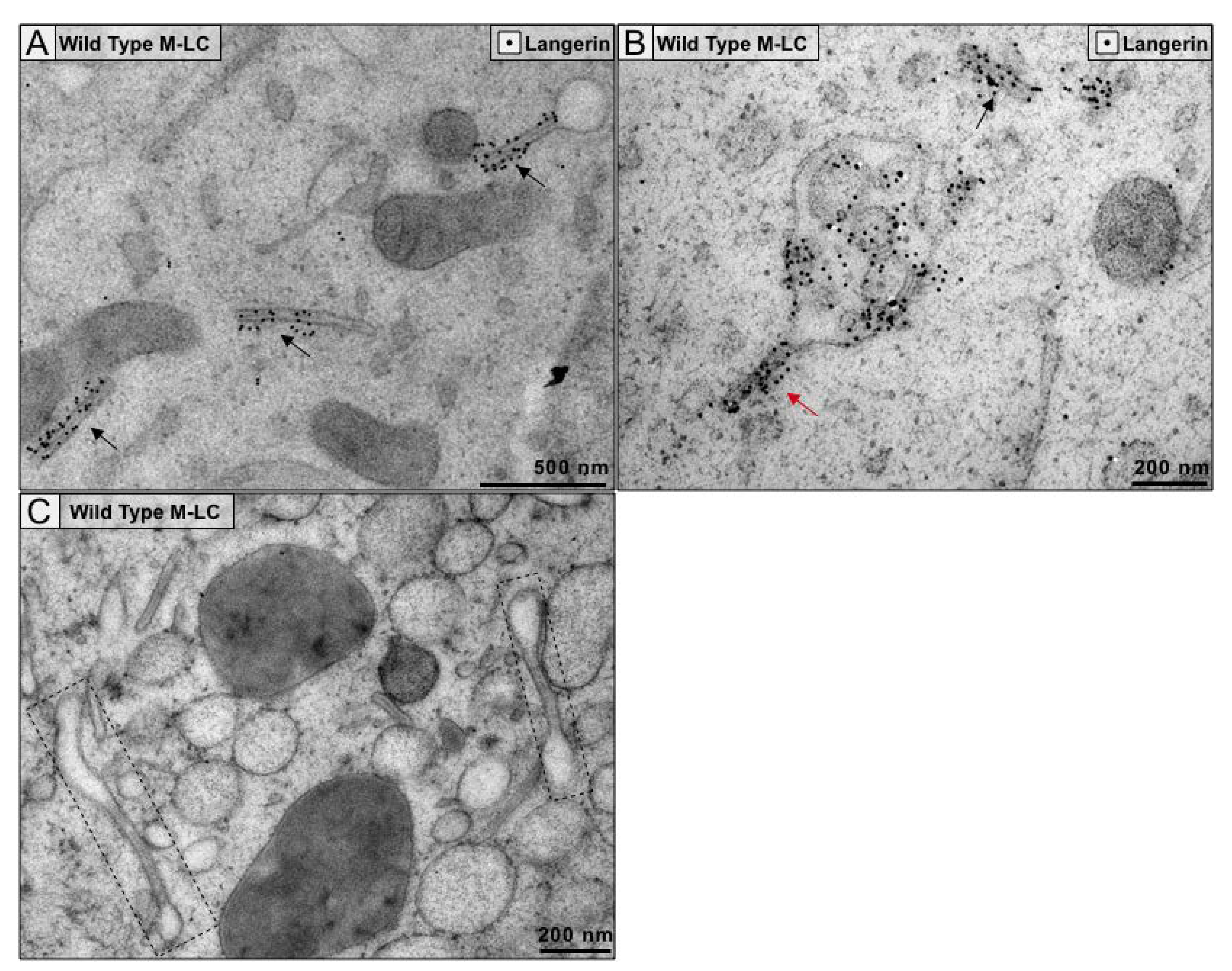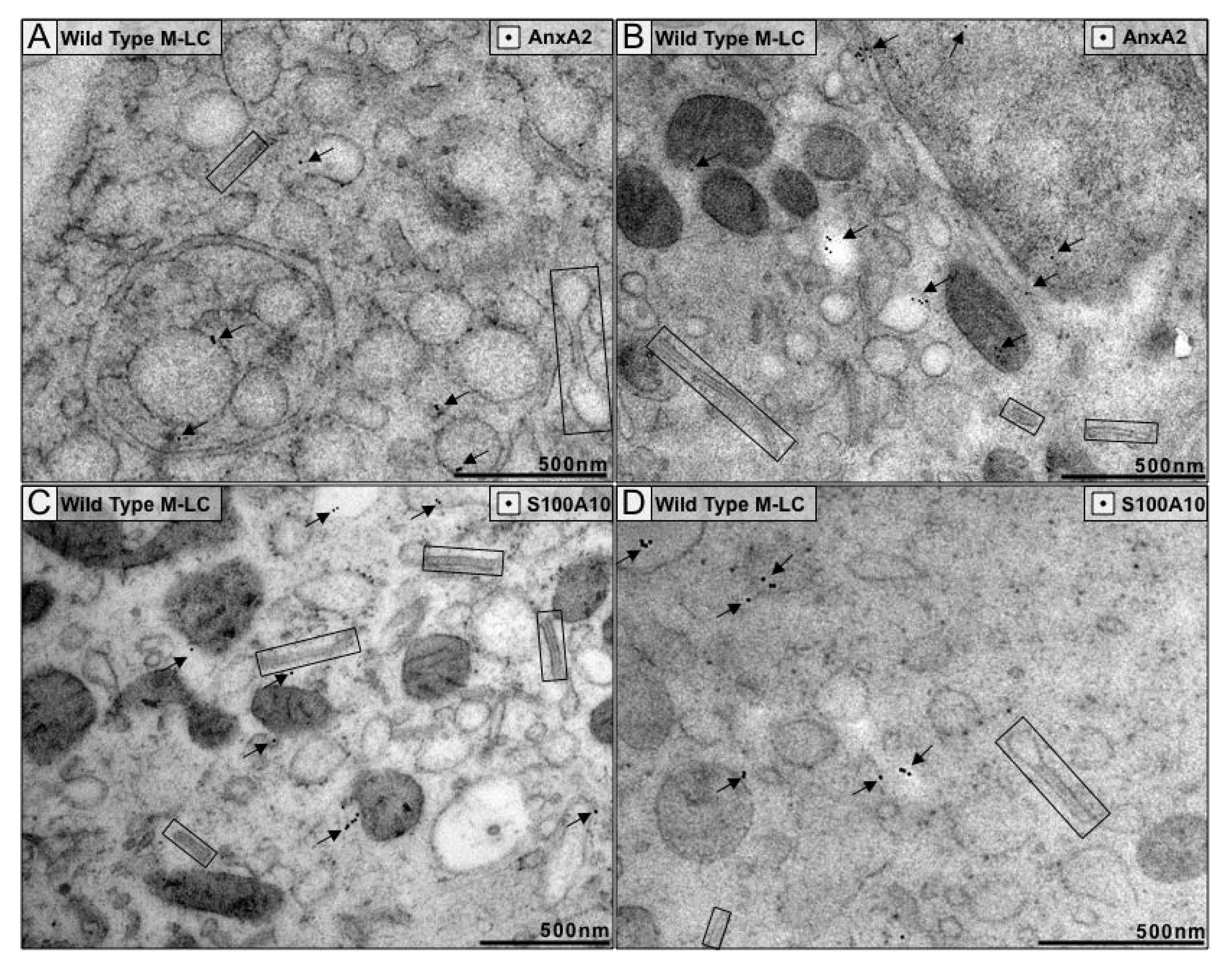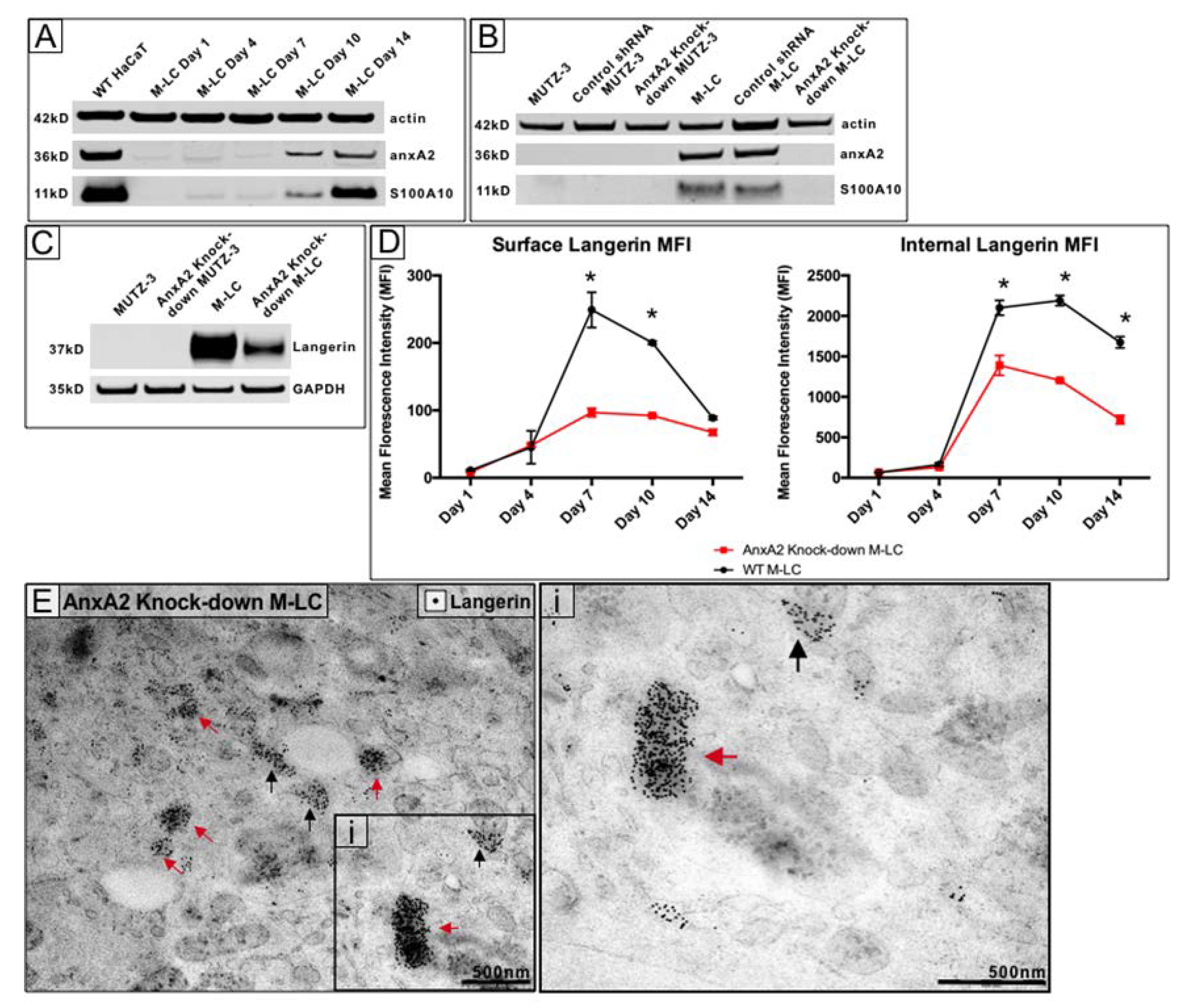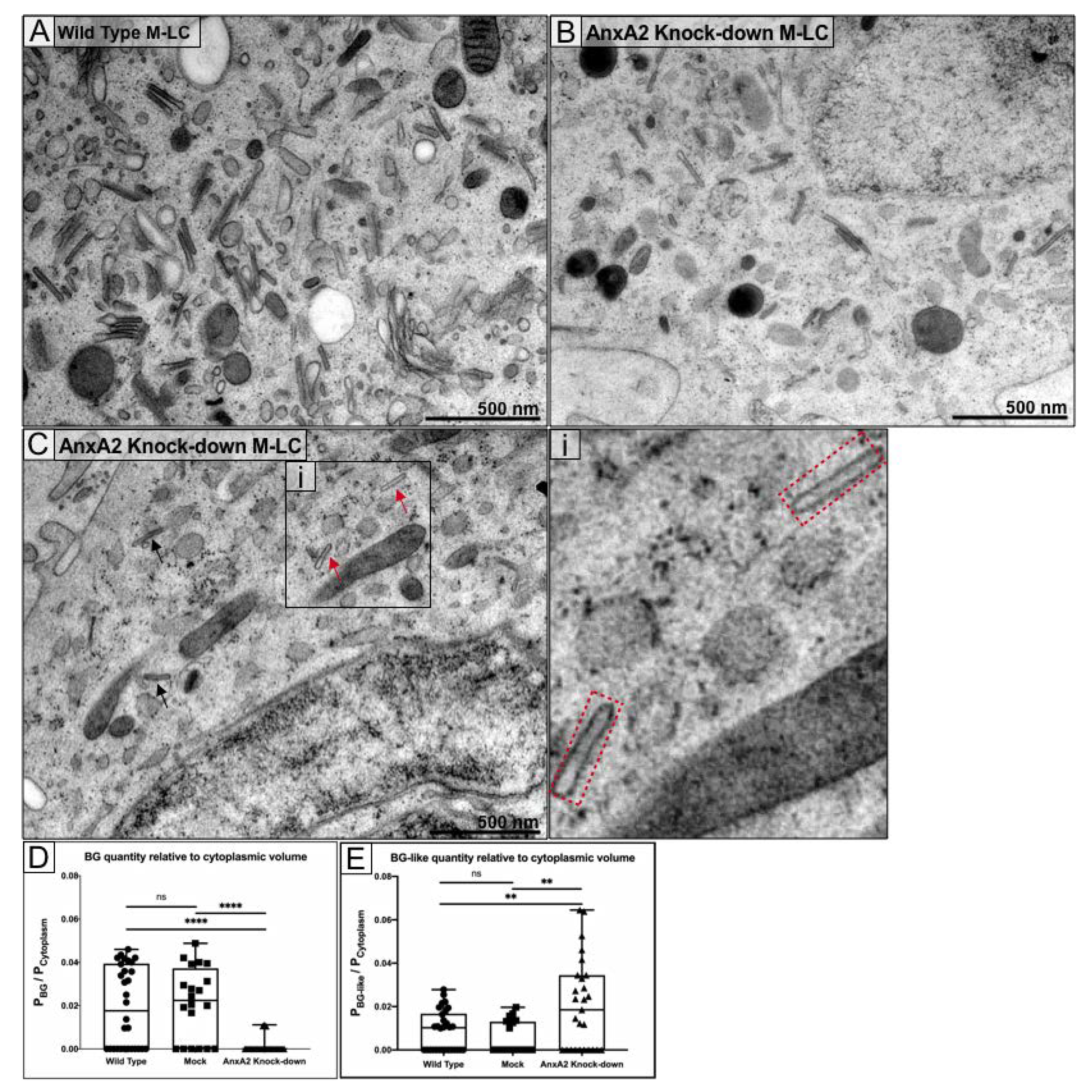The Essential Role of anxA2 in Langerhans Cell Birbeck Granules Formation
Abstract
1. Introduction
2. Materials and Methods
2.1. Cell Culture
2.2. Transmission Electron Microscopy
2.3. Immunoelectron Microscopy
2.4. shRNA-Mediated Knockdown of A2/A2t
2.5. Western Blot and Protein Quantification
2.6. Flow Cytometry
2.7. Quantification of BG
- Points landing on BG per points landing on cytoplasm = PBG/Pcytoplasm;
- Points landing on BG-like structures per points landing on cytoplasm = PBG-like/Pcytoplasm.
- A membrane structure was counted as BG-like if:
- 1.
- Sheet-shaped membrane =
- 2.
- Or elongated sheet-shaped invagination of the plasma membrane;
- 3.
- Not ER (no ribosomes);
- 4.
- Not Golgi (not part of a Golgi stack);
- 5.
- Not vesicular.

2.8. Statistical Analysis and Software Used
3. Results
3.1. MUTZ-3-Derived LC Are an Appropriate Model to Study BG Structure
3.2. Immunogold Staining of Langerin in M-LC Gives Insight into Proper BG Structure Formation and Demonstrates a Novel BG Structure
3.3. Neither Subunit of A2t Colocalizes to BG Structures
3.4. Knockdown of A2t Results in Reduced Expression and Non-BG Localization of Langerin
3.5. The Absence of A2t Results in Abnormal Cellular Distributionof Langerin and Incomplete BG Formation
4. Discussion
Supplementary Materials
Author Contributions
Funding
Conflicts of Interest
References
- Birbeck, M.S.; Breathnach, A.S.; Everall, J.D. An Electron Microscope Study of Basal Melanocytes and High-Level Clear Cells (Langerhans Cells) in Vitiligo. J. Invest. Dermatol. 1961, 37, 51–64. [Google Scholar] [CrossRef]
- Caputo, R.; Peluchetti, D.; Monti, M. Freeze-fracture of Langerhans granules. A comparative study. J. Invest. Dermatol. 1976, 66, 297–301. [Google Scholar] [CrossRef] [PubMed]
- Sagebiel, R.W. Serial reconstruction of the characteristic granule of the Langerhans Cell. J. Cell Biol. 1968, 36, 595–602. [Google Scholar] [CrossRef] [PubMed]
- Thépaut, M.; Valladeau, J.; Nurisso, A.; Kahn, R.; Arnou, B.; Vivès, C.; Saeland, S.; Ebel, C.; Monnier, C.; Dezutter-Dambuyant, C.; et al. Structural studies of Langerin and Birbeck granule: A macromolecular organization model. Biochemistry 2009, 48, 2684–2698. [Google Scholar] [CrossRef]
- Mc Dermott, R.; Ziylan, U.; Spehner, U.; Bausinger, H.; Lipsker, D.; Mommaas, M.; Cazenave, J.; Raposo, G.; Goud, B.; de la Salle, H.; et al. Birbeck Granules Are Subdomains of Endosomal Recycling Compartment in Human Epidermal Langerhans Cells, Which Form Where Langerin Accumulates. Mol. Biol. Cell 2002, 13, 317–335. [Google Scholar] [CrossRef]
- Deckers, J.; Hammad, H.; Hoste, E. Langerhans Cells: Sensing the Environment in Health and Disease. Front. Immunol. 2018, 9. [Google Scholar] [CrossRef]
- Valladeau, J.; Ravel, O.; Dezutter-Dambuyant, C.; Moore, K.; Kleijmeer, M.; Liu, Y.; Duvert-Frances, V.; Vincent, C.; Schmitt, D.; Davoust, J.; et al. Langerin, a novel C-type lectin specific to Langerhans cells, is an endocytic receptor that induces the formation of Birbeck granules. Immunity 2000, 12, 71–81. [Google Scholar] [CrossRef]
- Kissenpfennig, A.; Aït-Yahia, S.; Clair-Moninot, V.; Stössel, H.; Badell, E.; Bordat, Y.; Pooley, J.L.; Lang, T.; Prina, E.; Coste, I.; et al. Disruption of the langerin/CD207 Gene Abolishes Birbeck Granules without a Marked Loss of Langerhans Cell Function. Mol. Cell. Biol. 2005, 25, 88–99. [Google Scholar] [CrossRef]
- Turville, S.G.; Arthos, J.; Mac Donald, K.; Lynch, G.; Naif, H.; Clark, G.; Hart, D.; Cunningham, A.L. HIV gp120 receptors on human dendritic cells. Blood 2001, 98, 2482–2488. [Google Scholar] [CrossRef]
- De Witte, L.; Nabatov, A.; Pion, M.; Fluitsma, D.; de Jong, M.A.; de Gruijl, T.; Piguet, V.; van Kooyk, Y.; Geijtenbeek, T.B. Langerin is a natural barrier to HIV-1 transmission by Langerhans cells. Nat. Med. 2007, 13, 367–371. [Google Scholar] [CrossRef]
- Ribeiro, C.M.; Sarrami-Forooshani, R.; Setiawan, L.C.; Zijlstra-Willems, E.M.; van Hamme, J.L.; Tigchelaar, W.; van der Wel, N.N.; Kootstra, N.A.; Gringhuis, S.I.; Geijtenbeek, T.B.H. Receptor usage dictates HIV-1 restriction by human TRIM5α in dendritic cell subsets. Nature 2016, 540, 448–452. [Google Scholar] [CrossRef]
- Valladeau, J.; Dezutter-Dambuyant, C.; Saeland, S. Langerin/CD207 Sheds Light on Formation of Birbeck Granules and Their Possible Function in Langerhans Cells. Immunol. Res. 2003, 28, 93–107. [Google Scholar] [CrossRef]
- Merad, M.; Ginhoux, F.; Collin, M. Origin, homeostasis and function of Langerhans cells and other langerin-expressing dendritic cells. Nat. Rev. Immunol. 2008, 8, 935–947. [Google Scholar] [CrossRef]
- Uzan-Gafsou, S.; Bausinger, H.; Proamer, F.; Monier, S.; Lipsker, D.; Cazenave, J.; Goud, B.; de la Salle, H.; Hanau, D.; Salamero, J. Rab11A controls the biogenesis of Birbeck granules by regulating Langerin recycling and stability. Mol. Biol. Cell 2007, 18, 3169–3179. [Google Scholar] [CrossRef]
- Ng, W.C.; Londrigan, S.L.; Nasr, N.; Cunningham, A.L.; Turville, S.; Brooks, A.G.; Reading, P.C. The C-type Lectin Langerin Functions as a Receptor for Attachment and Infectious Entry of Influenza A Virus. J. Virol. 2015, 90, 206–221. [Google Scholar] [CrossRef]
- Gidon, A.; Bardin, S.; Cinquin, B.; Boulanger, J.; Waharte, F.; Heliot, L.; de la Salle, H.; Hanau, D.; Kervrann, C.; Goud, B.; et al. A Rab11A/Myosin Vb/Rab11-FIP2 Complex Frames Two Late Recycling Steps of Langerin from the ERC to the Plasma Membrane. Traffic 2012, 13, 815–833. [Google Scholar] [CrossRef]
- Chabrol, E.; Thépaut, M.; Dezutter-Dambuyant, C.; Vivès, C.; Marcoux, J.; Kahn, R.; Valladeau-Guilemond, J.; Vachette, P.; Durand, D.; Fieschi, F. Alteration of the Langerin oligomerization state affects Birbeck granule formation. Biophys. J. 2015, 108, 666–677. [Google Scholar] [CrossRef] [PubMed]
- Salamero, J.; Bausinger, H.; Mommaas, A.M.; Lipsker, D.; Proamer, F.; Cazenave, J.P.; Goud, B.; de la Salle, H.; Hanau, D. CD1a Molecules Traffic Through the Early Recycling Endosomal Pathway in Human Langerhans Cells. J. Invest. Dermatol. 2001, 116, 401–408. [Google Scholar] [CrossRef] [PubMed]
- Da Silva, D.M.; Movius, C.A.; Raff, A.B.; Brand, H.E.; Skeate, J.G.; Wong, M.K.; Kast, W.M. Suppression of Langerhans cell activation is conserved amongst human papillomavirus α and β genotypes, but not a µ genotype. Virology 2014, 452–453, 279–286. [Google Scholar] [CrossRef] [PubMed]
- Woodham, A.W.; Raff, A.B.; Raff, L.M.; Da Silva, D.M.; Yan, L.; Skeate, J.G.; Wong, M.K.; Lin, Y.G.; Kast, W.M. Inhibition of Langerhans cell maturation by human papillomavirus type 16: a novel role for the annexin A2 heterotetramer in immune suppression. J. Immunol. 2014, 192, 4748–4757. [Google Scholar] [CrossRef]
- Taylor, J.R.; Fernandez, D.J.; Thornton, S.M.; Skeate, J.G.; Lühen, K.P.; Da Silva, D.M.; Langen, R.; Kast, W.M. Heterotetrameric annexin A2/S100A10 (A2t) is essential for oncogenic human papillomavirus trafficking and capsid disassembly, and protects virions from lysosomal degradation. Sci. Rep. 2018, 8. [Google Scholar] [CrossRef] [PubMed]
- Buser, C.; Walther, P. Freeze-substitution: The addition of water to polar solvents enhances the retention of structure and acts at temperatures around −60 °C. J. Microsc. 2008, 230, 268–277. [Google Scholar] [CrossRef] [PubMed]
- McDonald, K.; Schwarz, H.; Müller-Reichert, T.; Webb, R.; Buser, C.; Morphew, M. “Tips and tricks” for high-pressure freezing of model systems. Methods Cell Biol. 2010, 96, 671–693. [Google Scholar] [CrossRef] [PubMed]
- Buser, C.; Drubin, D.G. Ultrastructural Imaging of Endocytic Sites in Saccharomyces cerevisiae by Transmission Electron Microscopy and Immunolabeling. Microsc. Microanal. 2013, 19, 381–392. [Google Scholar] [CrossRef] [PubMed]
- Masterson, A.J.; Sombroek, C.C.; De Gruijl, T.D.; Graus, Y.M.; van der Vliet, H.J.; Lougheed, S.M.; van den Eertwegh, A.J.; Pinedo, H.M.; Scheper, R.J. MUTZ-3, a human cell line model for the cytokine-induced differentiation of dendritic cells from CD34+precursors. Blood 2002, 100, 701–703. [Google Scholar] [CrossRef] [PubMed]
- de Jong, M.A.; de Witte, L.; Santegoets, S.J.; Fluitsma, D.; Taylor, M.E.; de Gruijl, T.D.; Geijtenbeek, T.B. Mutz-3-derived Langerhans cells are a model to study HIV-1 transmission and potential inhibitors. J. Leukoc. Biol. 2010, 87, 637–643. [Google Scholar] [CrossRef]
- Santegoets, S.J.; Schreurs, M.W.; Masterson, A.J.; Liu, Y.P.; Goletz, S.; Baumeister, H.; Kueter, E.W.; Lougheed, S.M.; van den Eertwegh, A.J.; Scheper, R.J.; et al. In vitro priming of tumor-specific cytotoxic T lymphocytes using allogeneic dendritic cells derived from the human MUTZ-3 cell line. Cancer Immunol. Immunother. 2006, 55, 1480–1490. [Google Scholar] [CrossRef]
- Larsson, K.; Lindstedt, M.; Borrebaeck, C.A.K. Functional and transcriptional profiling of MUTZ-3, a myeloid cell line acting as a model for dendritic cells. Immunology 2006, 117, 156–166. [Google Scholar] [CrossRef]
- van den Berg, L.M.; Ribeiro, C.M.S.; Zejlstra-Willems, E.; de Witte, L.; Fluitsma, D.; Tigchelaar, W.; Everts, V.; Geijtenbeek, T.B.H. Caveolin-1 mediated uptake via langerin restricts HIV-1 infection in human Langerhans cells. Retrovirology 2014, 11, 1–9. [Google Scholar] [CrossRef]
- Griffiths, G. Quantitative Aspects of Immunocytochemistry. In Fine Structure Immunocytochemistry; Springer: Berlin/Heidelberg, Germany, 1993; pp. 371–445. [Google Scholar] [CrossRef]
- Stambach, N.S.; Taylor, M.E. Characterization of carbohydrate recognition by langerin, a C-type lectin of Langerhans cell. Glycobiology 2003, 13, 401–410. [Google Scholar] [CrossRef]
- Morel, E.; Parton, R.G.; Gruenberg, J. Annexin A2-Dependent Polymerization of Actin Mediates Endosome Biogenesis. Dev. Cell 2009, 16, 445–457. [Google Scholar] [CrossRef] [PubMed]
- Bharadwaj, A.; Bydoun, M.; Holloway, R.; Waisman, D. Annexin A2 heterotetramer: Structure and function. Int. J. Mol. Sci. 2013, 14, 6259–6305. [Google Scholar] [CrossRef] [PubMed]
- Trischler, M.; Stoorvogel, W.; Ullrich, O. Biochemical analysis of distinct Rab5- and Rab11-positive endosomes along the transferrin pathway. J. Cell Sci. 1999, 112, 4773–4783. [Google Scholar] [PubMed]
- Zobiack, N.; Rescher, U.; Ludwig, C.; Zeuschner, D.; Gerke, V. The annexin 2/S100A10 complex controls the distribution of transferrin receptor-containing recycling endosomes. Mol. Biol. Cell 2003, 14, 4896–4908. [Google Scholar] [CrossRef]




© 2020 by the authors. Licensee MDPI, Basel, Switzerland. This article is an open access article distributed under the terms and conditions of the Creative Commons Attribution (CC BY) license (http://creativecommons.org/licenses/by/4.0/).
Share and Cite
Thornton, S.M.; Samararatne, V.D.; Skeate, J.G.; Buser, C.; Lühen, K.P.; Taylor, J.R.; Da Silva, D.M.; Kast, W.M. The Essential Role of anxA2 in Langerhans Cell Birbeck Granules Formation. Cells 2020, 9, 974. https://doi.org/10.3390/cells9040974
Thornton SM, Samararatne VD, Skeate JG, Buser C, Lühen KP, Taylor JR, Da Silva DM, Kast WM. The Essential Role of anxA2 in Langerhans Cell Birbeck Granules Formation. Cells. 2020; 9(4):974. https://doi.org/10.3390/cells9040974
Chicago/Turabian StyleThornton, Shantae M., Varsha D. Samararatne, Joseph G. Skeate, Christopher Buser, Kim P. Lühen, Julia R. Taylor, Diane M. Da Silva, and W. Martin Kast. 2020. "The Essential Role of anxA2 in Langerhans Cell Birbeck Granules Formation" Cells 9, no. 4: 974. https://doi.org/10.3390/cells9040974
APA StyleThornton, S. M., Samararatne, V. D., Skeate, J. G., Buser, C., Lühen, K. P., Taylor, J. R., Da Silva, D. M., & Kast, W. M. (2020). The Essential Role of anxA2 in Langerhans Cell Birbeck Granules Formation. Cells, 9(4), 974. https://doi.org/10.3390/cells9040974






